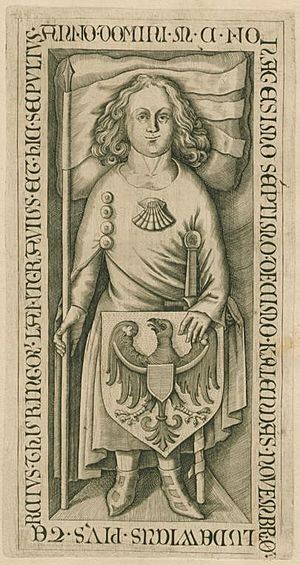Louis III, Landgrave of Thuringia facts for kids
Quick facts for kids Louis III, Landgrave of Thuringia |
|
|---|---|
 |
|
| Grave plate of Louis III, Landgrave of Thuringia | |
| Spouse(s) | Margaret of Cleves Sophia of Minsk |
| Noble family | Ludovingians |
| Father | Louis II, Landgrave of Thuringia |
| Mother | Judith of Hohenstaufen |
| Born | 1151 or 1152 |
| Died | 16 October 1190 Eastern Mediterranean Sea, near Cyprus |
| Burial | Reinhardsbrunn |
Louis III, often called Louis the Pious or Louis the Mild, was an important ruler from a family known as the Ludovingians. He was born around 1151 or 1152. From 1172 until his death in 1190, he served as the Landgrave of Thuringia. A Landgrave was a powerful noble who governed a large territory, similar to a duke or prince.
Contents
Louis III: A Medieval Ruler
Becoming Landgrave
Louis III was the oldest son of Landgrave Louis II and his wife Judith of Hohenstaufen. When his father passed away in 1172, Louis III took over as the Landgrave of Thuringia. His younger brother, Henry Raspe III, received the lands of Hesse and other family properties near the Rhine River.
Challenges and Alliances
Louis III largely followed the same plans as his father. He often had conflicts, known as feuds, with other noble families in Thuringia. He also had disagreements with rulers from nearby areas, like the House of Schwarzburg and the House of Ascania. The Archbishopric of Mainz, a powerful church territory, was another frequent opponent.
Louis III was the nephew of Emperor Frederick Barbarossa, a very famous and powerful ruler. Louis supported the Emperor's plans and policies. At first, Louis was an ally of Henry the Lion, a strong duke from the House of Welf. However, when Henry the Lion had a major disagreement with the Emperor's family, the Hohenstaufens, in 1179, Louis III changed sides. He then supported Henry's opponents in Saxony. As a reward for his loyalty, Emperor Frederick Barbarossa gave Louis the County Palatine of Saxony in 1180. However, Louis soon gave this land to his brother, Hermann I, Landgrave of Thuringia, in 1181.
A Close Call in Erfurt
In 1184, Louis III was present at a large meeting of nobles, called a Hoftag, held by Emperor Henry VI in Erfurt. This meeting took place at the Petersberg Citadel. During the event, a terrible accident happened. The floor of the building broke, and about 60 nobles fell into the latrine (a toilet pit) below. Many people died in this Erfurt latrine disaster. Luckily, Louis III was one of the few survivors of this shocking event.
Journey to the Holy Land
Joining the Third Crusade
Louis III decided to join the Third Crusade, a major military journey to the Holy Land. While the main army, led by Emperor Frederick Barbarossa, traveled by land through the Balkans and Asia Minor, Louis III chose a different route. He and his group boarded ships in Brindisi, a port city, and sailed across the sea to Tyre, a city in the Holy Land.
Fighting in Acre and His Final Journey
After arriving in the Holy Land, Louis III took part in the siege of Acre. This was a long and difficult battle to capture the city. However, before Emperor Barbarossa and the main army arrived, Louis III became very ill. He decided to return home because of his sickness. Sadly, he died on his ship while sailing near Cyprus on October 16, 1190.
His internal organs were buried on the island of Cyprus. His bones, however, were later brought back to the Reinhardsbrunn monastery in Thuringia. In the 14th century, his bones were moved again and reburied in the Church of St. George in Eisenach.

